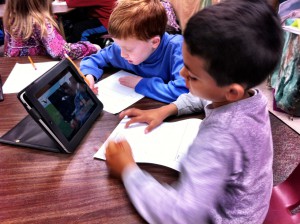Blended learning is widely considered one of the most significant instructional reforms ever to hit K-12 education. Learning in part through the use of digital and online media, students undertaking blended learning programs pursue a more diverse course of study, gaining an element of control over time, place, path, or pace. According to Michael B. Horn and Heather Staker in The Rise of K–12 Blended Learning, “In the year 2000, roughly 45,000 K–12 students took an online course. In 2009, more than 3 million K–12 students did.” The speed with which online learning is accelerating has made it virtually impossible for schools to ignore, leading to increasing concerns about the future of brick-and-mortar learning environments, and the role of the educator. Blended learning came in response to these growing concerns, presenting a compromise of sorts between two opposing needs. Offering a balance between online and face-to-face instruction, blended learning seems to offer the ideal solution, facilitating technology’s inevitable move into the learning sphere, while appreciating the value of diverse pedagogy.
Why Are Schools Opting for Change?
The reasons behind changing practice reach far beyond a simple necessity to integrate technology. Rising numbers of K-12 schools and educators are opting for blended learning models that replace traditional methods in an attempt to maximize class time, to offer personalized instruction, and to facilitate students ‘going deeper’ and taking more control over their own learning. Encouraging more collaboration, and independent learning, “teachers shifting to blended-learning models are finding that they have more time to focus on high-value activities like critical thinking, writing, and project-based learning as they spend less time on low-value, manual tasks.” Forming a more diverse and adaptive learning environment, blended learning essentially attempts to meet the different needs of every student in a particular class, facilitating “a more consistent and personalized pedagogy that allows each student to work at her own pace, and helps each child feel and be successful at school.”
What Role Does Technology Play?
While the tools and the methods differ from class to class, much of the focus of blended learning remains on par; In an attempt to provide for the varying needs and levels within each class, blended learning realizes the potential for technology to act as a ‘personalization-enabler’, enhancing the learning experience for every student. Viewed as an essential tool in the construction of a blended learning environment, technology plays its part in taking the diverse nature of blended learning to the next level, saving educators time, while offering students more support, flexibility, and control.
Although blended models have been around for quite some time, it’s only now that we’re beginning to see the technology emerge that really meets the requirements of an effective blended learning environment. As the overcrowded marketplace for educational technology continues to expand, many educators are now drowning under apps, as opposed to paper. Yet, all-in-one solutions are thankfully making their way to center stage, offering educators a one-stop-shop for all their blending needs. Adaptive learning platforms like Fishtree incorporate personalization, social media, and analytics in an attempt to make the move to a blended environment as simple and manageable as possible. With endless resources tailored to every student, real-time messaging for instant collaboration, and complete transparency into the learning path of every student, educators are empowered to make their blended learning environment as effective and rewarding as possible.
Like what you’ve read? Join our webinar series Teaching with Tech: Getting Started with Blended Learning or check out fishtree.com for more!
About the author:
Lorna Keane specializes in language teaching and has taught in second and third-level institutions in several countries. She holds a B.A in languages and cultural studies and an M.A in French literature, theory and visual culture. Follow her on Twitter or connect on LinkedIn.
